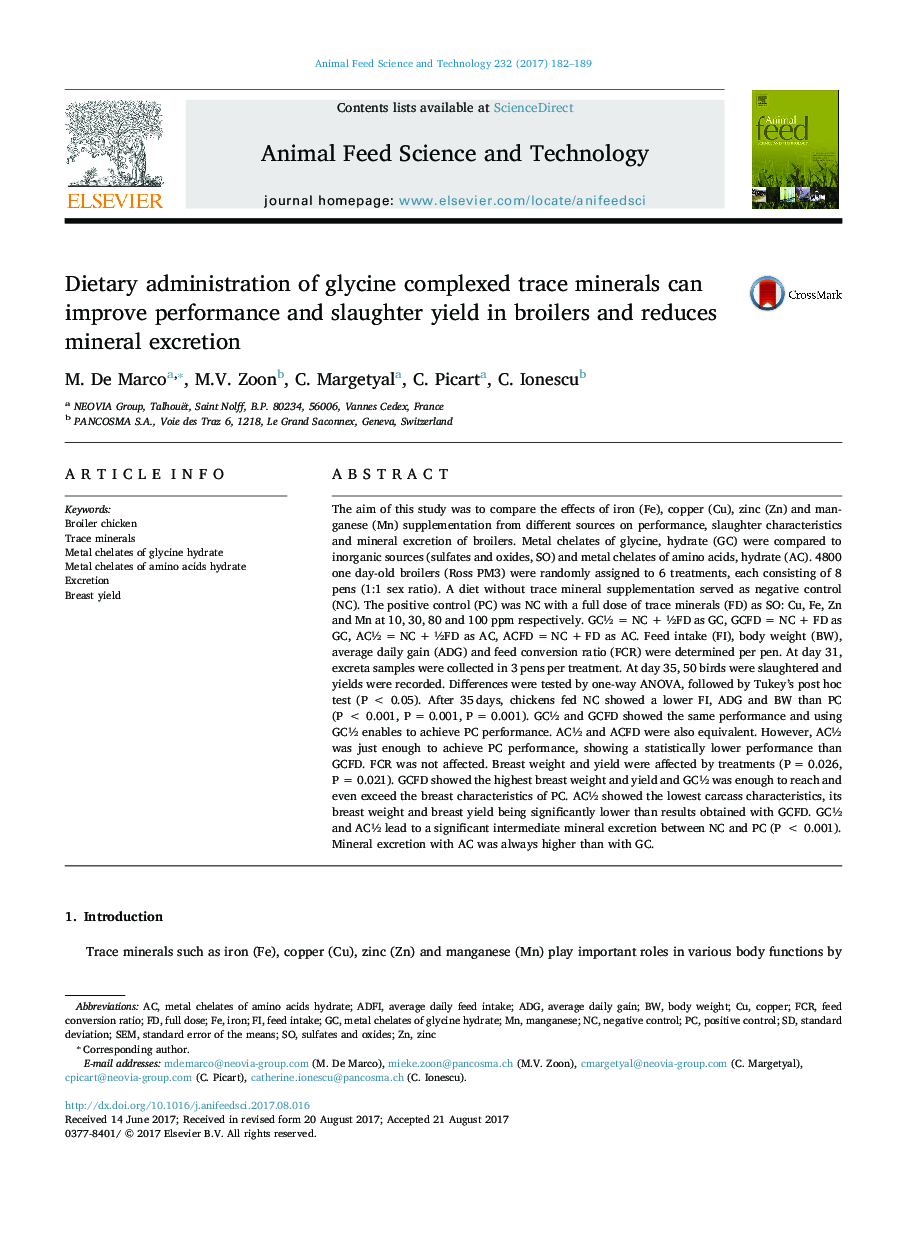| کد مقاله | کد نشریه | سال انتشار | مقاله انگلیسی | نسخه تمام متن |
|---|---|---|---|---|
| 5538678 | 1552354 | 2017 | 8 صفحه PDF | دانلود رایگان |
عنوان انگلیسی مقاله ISI
Dietary administration of glycine complexed trace minerals can improve performance and slaughter yield in broilers and reduces mineral excretion
ترجمه فارسی عنوان
استفاده از مواد معدنی رقیق شده گلیسین می تواند عملکرد و عملکرد کشت در جوجه های گوشتی را بهبود بخشد و دفع مواد معدنی را کاهش دهد
دانلود مقاله + سفارش ترجمه
دانلود مقاله ISI انگلیسی
رایگان برای ایرانیان
کلمات کلیدی
ADGADFIFCRIron - آهنstandard deviation - انحراف معیارExcretion - تخفیفBroiler chicken - جوجه گوشتیstandard error of the means - خطای استاندارد از وسایلTrace minerals - ردیابی مواد معدنیZinc - فلز رویaverage daily gain - متوسط افزایش روزانهSEM - مدل معادلات ساختاری / میکروسکوپ الکترونی روبشیCopper - مسFeed intake - مصرف غذاManganese - منگنز Average daily feed intake - میانگین مصرف خوراک روزانهfeed conversion ratio - نسبت تبدیل خوراکbody weight - وزن بدنPositive control - کنترل مثبتnegative control - کنترل منفی
موضوعات مرتبط
علوم زیستی و بیوفناوری
علوم کشاورزی و بیولوژیک
علوم دامی و جانورشناسی
چکیده انگلیسی
The aim of this study was to compare the effects of iron (Fe), copper (Cu), zinc (Zn) and manganese (Mn) supplementation from different sources on performance, slaughter characteristics and mineral excretion of broilers. Metal chelates of glycine, hydrate (GC) were compared to inorganic sources (sulfates and oxides, SO) and metal chelates of amino acids, hydrate (AC). 4800 one day-old broilers (Ross PM3) were randomly assigned to 6 treatments, each consisting of 8 pens (1:1 sex ratio). A diet without trace mineral supplementation served as negative control (NC). The positive control (PC) was NC with a full dose of trace minerals (FD) as SO: Cu, Fe, Zn and Mn at 10, 30, 80 and 100 ppm respectively. GC½ = NC + ½FD as GC, GCFD = NC + FD as GC, AC½ = NC + ½FD as AC, ACFD = NC + FD as AC. Feed intake (FI), body weight (BW), average daily gain (ADG) and feed conversion ratio (FCR) were determined per pen. At day 31, excreta samples were collected in 3 pens per treatment. At day 35, 50 birds were slaughtered and yields were recorded. Differences were tested by one-way ANOVA, followed by Tukey's post hoc test (P < 0.05). After 35 days, chickens fed NC showed a lower FI, ADG and BW than PC (P < 0.001, P = 0.001, P = 0.001). GC½ and GCFD showed the same performance and using GC½ enables to achieve PC performance. AC½ and ACFD were also equivalent. However, AC½ was just enough to achieve PC performance, showing a statistically lower performance than GCFD. FCR was not affected. Breast weight and yield were affected by treatments (P = 0.026, P = 0.021). GCFD showed the highest breast weight and yield and GC½ was enough to reach and even exceed the breast characteristics of PC. AC½ showed the lowest carcass characteristics, its breast weight and breast yield being significantly lower than results obtained with GCFD. GC½ and AC½ lead to a significant intermediate mineral excretion between NC and PC (P < 0.001). Mineral excretion with AC was always higher than with GC.
ناشر
Database: Elsevier - ScienceDirect (ساینس دایرکت)
Journal: Animal Feed Science and Technology - Volume 232, October 2017, Pages 182-189
Journal: Animal Feed Science and Technology - Volume 232, October 2017, Pages 182-189
نویسندگان
M. De Marco, M.V. Zoon, C. Margetyal, C. Picart, C. Ionescu,
